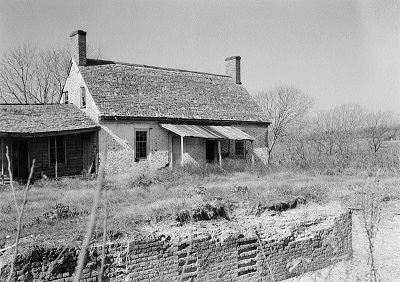
Courtesy of Library of Congress, Prints & Photographs Division, VA,48-WIL.V,4-1
Kingsmill Plantation is a large tract of land in James City County that played a significant role in the growth and development of the Jamestown colony. When the first colonists arrived, Gabriel Archer proposed that they currently the currently-named Hope section of Kingsmill their new home. This location was situated slightly west of Jamestown and allowed ships to anchor closer to shore. More than a decade later, Richard Kingsmill, a prominent member of the Virginia Company of London, settled on Kingsmill's first 300 acres. Following Kingsmill, the property was owned by Colonel Lewis Burwell III. Burwell was a member of the Governor's Council, the first elected legislative assembly in the new world. He named Kingsmill Plantation after his grandfather, Richard Kingsmill. The plantation house was a grand 4,800 square foot two-story manor that overlooked the James River. The plantation also included two brick dependencies, a coach house, dairy, stable, barn, and two wells. The manor was destroyed by fire in 1846. Today, one the brick dependencies and original garden steps remains.
Nearby are the remains of Burwell's Landing, a ferry and warehouse, Burwell's Ordinary, and the Pettus and Bray Plantations. Burwell's Landing became a major port of entry for Williamsburg during the 1700s and played a significant role in the American Revolution. Burwell's Ordinary served as the social hub of the area. It provided travelers with entertainment, horse stables, storage, and supplies.
In the 1970s, Dr. William Kelso, an historical archeologist, happened upon a well shaft on a cliff on the James River. This accidental discovery would lead to a three year excavation of over 15 separate sites. on Kingsmill Plantation. Collectively these sites contribute over 200 years of history about the colonial Tidewater region. The excavations helped piece together details of daily life on a plantation as well as much needed architectural information.
Today, Kingsmill Plantation is encased in the Plantation Course at the Kingmill Resort in Williamsburg. The course is a 6, 432 yard, par 72 course from which several archeological sites can be seen. Kingsmill Plantation was listed on the National Register of Historic Places on April 26, 1972 and the Virginia Landmarks Register on March 31, 1972. For more information, please visit: Kingsmill Plantation-Plantation Course or call (800) 832-5665.
Last updated: August 16, 2017
